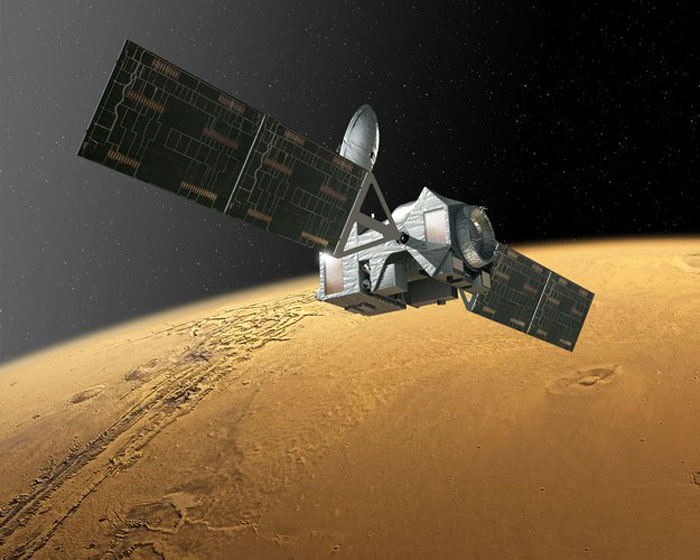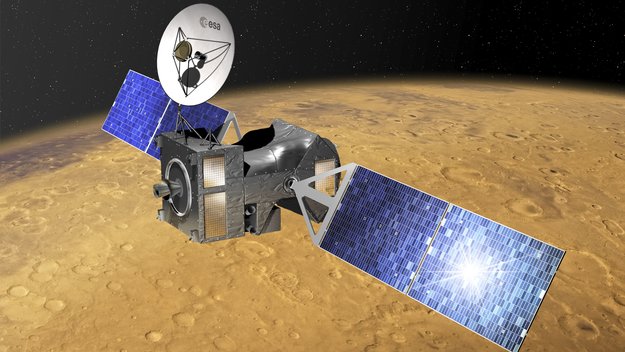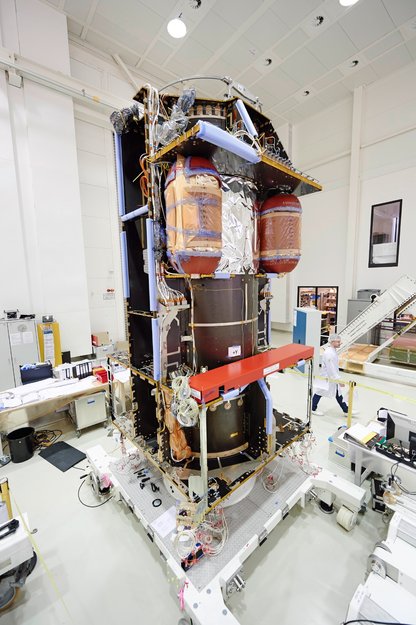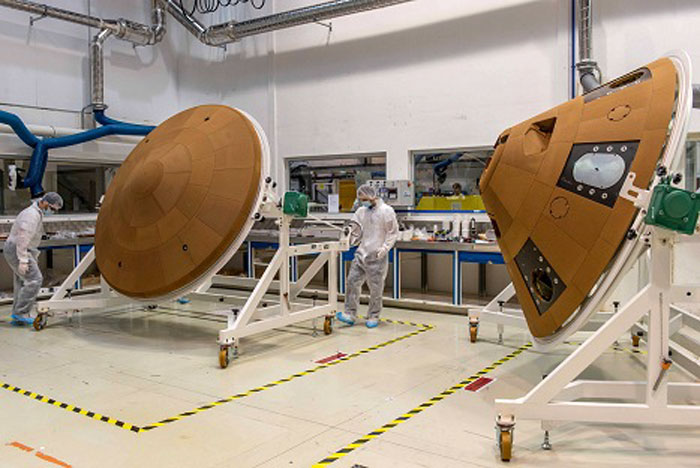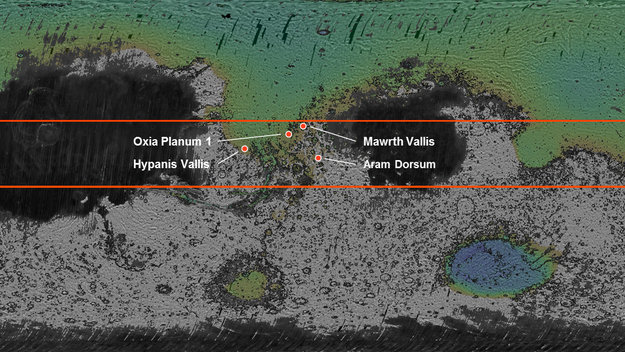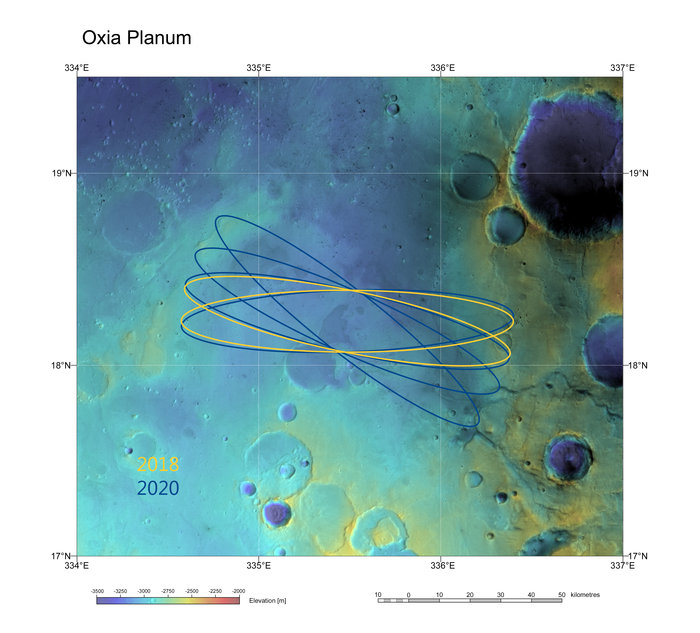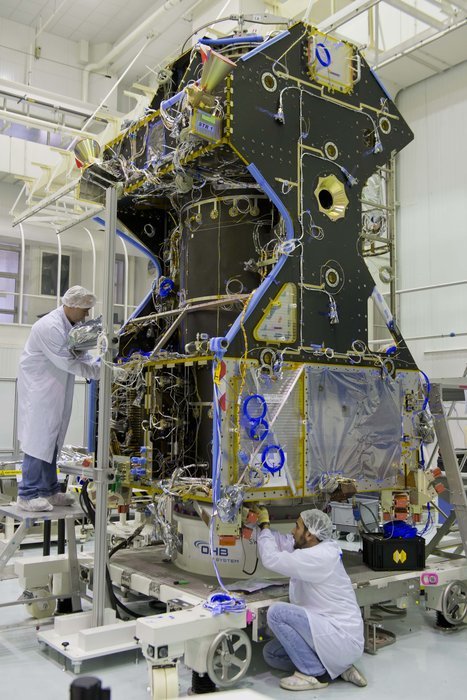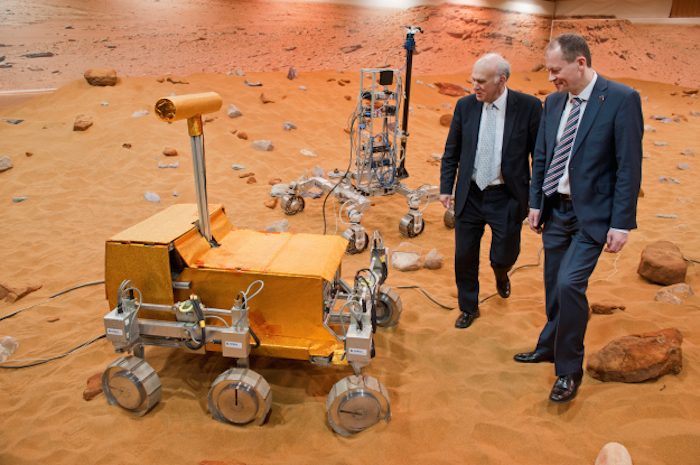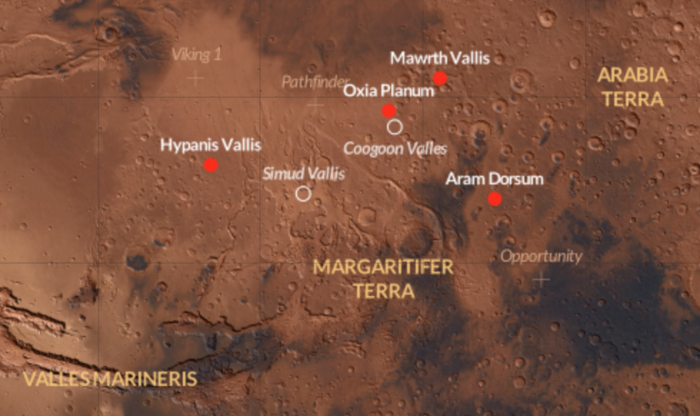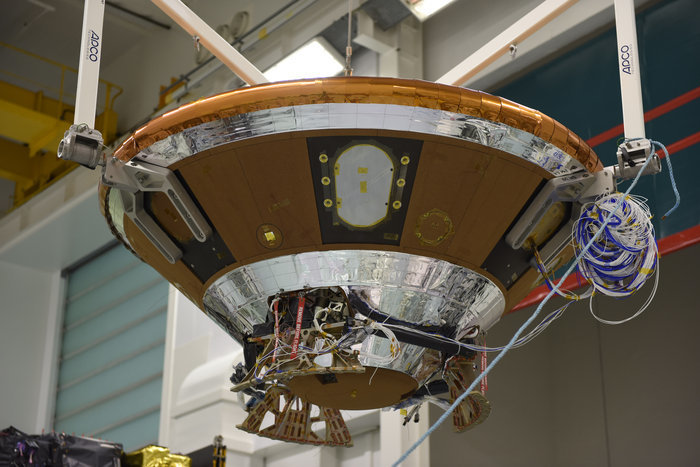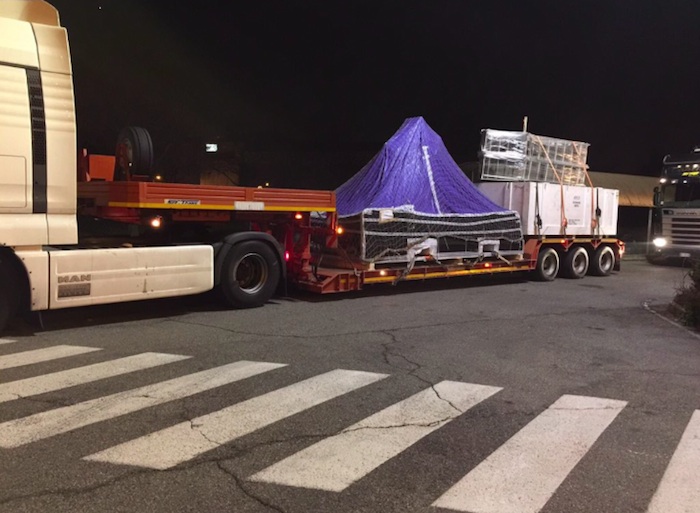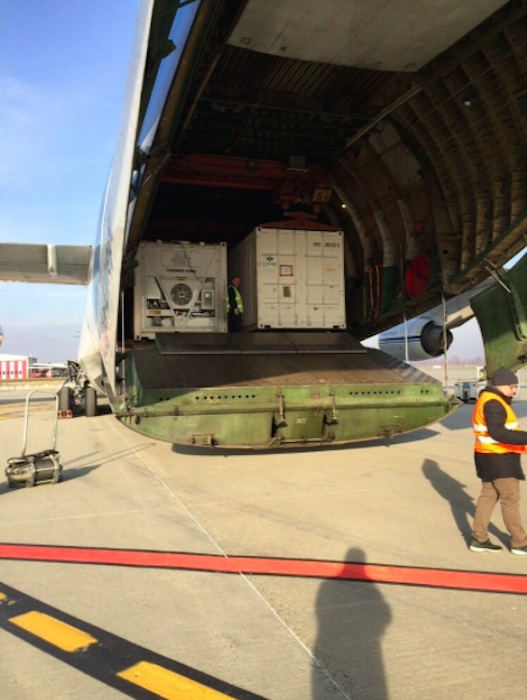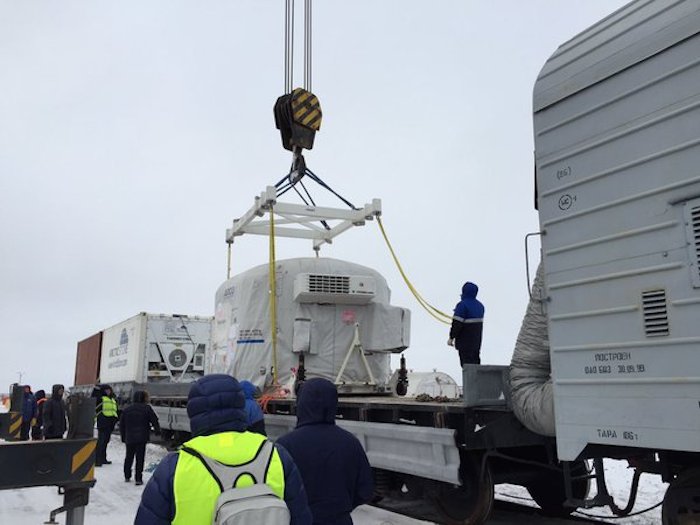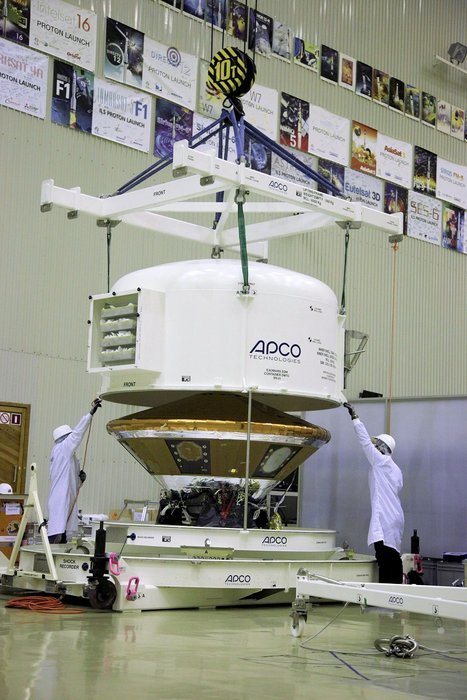A problem recently discovered in two sensors in the propulsion system of the entry, descent and landing demonstrator module has prompted the recommendation to move the launch of the ExoMars 2016 mission, initially foreseen in January, to March, still within the launch window of early 2016.
ExoMars is a joint endeavour between ESA and Russia’s Roscosmos space agency. The recommendation was made in full coordination between the two agencies and will be finally endorsed by a joint steering board on 24 September.
The Schiaparelli module will prove key technologies to demonstrate Europe’s capability to make a controlled landing on Mars.
The 600 kg Schiaparelli will ride to Mars on the Trace Gas Orbiter, which will subsequently enter orbit around the Red Planet to begin its five-year mission of studying atmospheric gases potentially linked to present-day biological or geological activity.
Schiaparelli will separate from the orbiter three days before they reach Mars, entering the atmosphere at 21 000 km/h. Following aerobraking in the upper atmosphere and a parachute phase, a liquid-propellant thruster system will brake the module to less than 5 km/h at a height of about 2 m above the surface.
At that moment, the thrusters will be switched off and the lander will drop to the ground, where the impact will be cushioned by a crushable structure built into the module.
Less than eight minutes will elapse between the moment when Schiaparelli enters the atmosphere to its landing on Mars in a region known as Meridiani Planum.
However, a defect was recently found in two pressure transducers mounted in the propulsion system.
“A failure in the production process of the pressure transducers has been identified and this leads to concerns about leakage, which represents a major risk to a successful landing on Mars,” says Don McCoy, ESA ExoMars Project Manager.
“ESA has decided not to accept this risk and to remove both units from the landing module, the knock-on effect being that we can no longer maintain the January 2016 launch window and will instead move to the back-up launch window in March.
“We are pleased to have identified the issue in good time, and are focusing all our efforts to launch on 14 March.”
The sensors are not part of the control loop necessary for landing, but would rather have gathered ancillary data for monitoring the system. In order to meet the new launch window, the decision was made to remove the parts, rather than replace them.
The later window is open 14–25 March and, thanks to the relative orbital positions of Earth and Mars, the mission will still arrive at Mars in October, just as if launched in January.
A set of scientific sensors on Schiaparelli will collect data on the atmosphere during the entry and descent, and its instruments will perform local environment measurements at the landing site.
Quelle: ESA
-
Update: 26.09.2015
.
ExoMars-1 Mission Launch Officially Delayed Until March 2016
Roscosmos announced that the launch of a space orbiter to Mars under a joint Russia-EU research program had been postponed until March 2016.
MOSCOW — The launch of a space orbiter to Mars under a joint Russia-EU research program has been postponed until March 2016, the Russian Federal Space Agency, Roscosmos, said on Friday.
The launch of the ExoMars-1 mission was originally scheduled for January 7, 2016. Last week, Roscosmos and the European Space Agency (ESA) proposed postponing the launch of until March 2016, citing technical reasons that required additional inspections of the mission equipment.
"Today, on September 25, 2015, a meeting of the Governing Council of the ExoMars mission was held in the Dutch city of Noordwijk. The Council members, Roscosmos and ESA experts have decided to postpone the start of the mission from January to March next year due to the need to replace equipment on ESA — Schiaparelli demonstration descent," the Roscosmos' press service said.
According to the statement, the mission will be launched between March 14 and 26.
Overall, Roscosmos and ESA have agreed to launch two ExoMars missions, scheduled for 2016 and 2018 respectively.
In 2016, it is planned to launch the orbiter, the main goal of which is to study the atmosphere of Mars and to conduct data exchange with a rover. The rover itself is scheduled to be sent to the planet in 2018.
Quelle: Sputnik
.
Update: 22.10.2015
.
Landing site recommended for ExoMars 2018
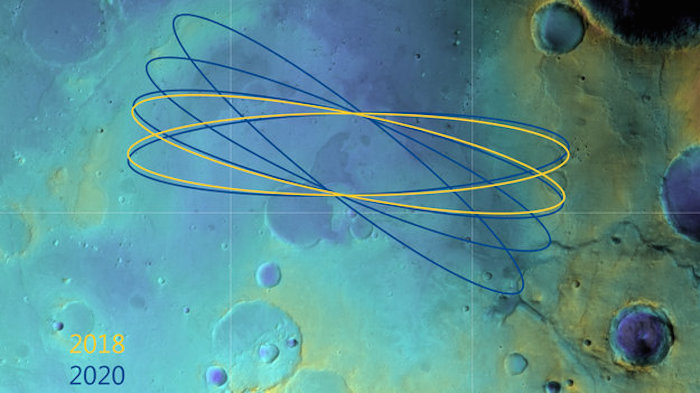
Oxia Planum has been recommended as the primary candidate for the landing site of the ExoMars 2018 mission.
ExoMars 2018, comprising a rover and surface platform, is the second of two missions making up the ExoMars programme, a joint endeavour between ESA and Russia’s Roscosmos. Launch is planned for May 2018, with touchdown on the Red Planet in January 2019.
Meanwhile, the Trace Gas Orbiter and the Schiaparelli entry, descent and landing demonstrator module will be launched in March 2016, arriving at Mars around this time next year.
Schiaparelli will land in Meridiani Planum. The orbiter will study the atmosphere and act as a relay for the second mission.
The search for a suitable landing site for the second mission began in December 2013, when the science community was asked to propose candidates. In October 2014, the Landing Site Selection Working Group chose four sites. The last year has been spent evaluating these sites, taking into account the engineering constraints of descent and landing, and the best possible scientific return of the mission
The main goal for the rover is to search for evidence of martian life, past or present, in an area with ancient rocks where liquid water was once abundant. A drill is capable of extracting samples from up to 2 m below the surface. This is crucial, because the present surface of Mars is a hostile place for living organisms owing to the harsh solar and cosmic radiation. By searching underground, the rover has more chance of finding preserved evidence.
Scientists believe that primitive life could have gained a foothold when the surface environment was wetter, more than 3.6 billion years ago. Buried or recently exhumed layered sedimentary deposits thus offer the best window into this important period of Mars history.
.
Screenshot from the Where On Mars? visualisation tool depicting the location of four candidate landing sites (red markers) for ExoMars 2018. Visit the site to explore the landing regions in more detail.
.
All four sites under study – Aram Dorsum, Hypanis Vallis, Mawrth Vallis and Oxia Planum – show evidence of having been influenced by water in the past, and are likely representative of global processes operating in the Red Planet’s early history.
All locations offer the opportunity of landing at a scientifically interesting site or finding one within a 1 km drive from the touchdown point, with numerous targets accessible along a typical 2 km traverse planned for the mission of 218 martian days (each 24 hours 37 minutes).
Quelle: ESA
-
Update: 25.11.2015
.
ExoMars prepares to leave Europe for launch site
The two ExoMars spacecraft of the 2016 mission are being prepared for shipping to the Baikonur Cosmodrome in Kazakhstan ahead of their launch in March.
A joint endeavour with Russia’s Roscosmos space agency, ExoMars comprises two missions. The Trace Gas Orbiter (TGO) and Schiaparelli make up the 2016 mission, while the 2018 mission will combine a rover and a surface science platform. Both missions will be launched on Russian Proton rockets from Baikonur.
TGO and Schiaparelli are undergoing final preparations at Thales Alenia Space in Cannes, France, where they were today on display for media to view for the last time before they leave Europe.
They will be shipped separately in the middle of next month, arriving at the cosmodrome on 21 and 23 December, respectively.
.
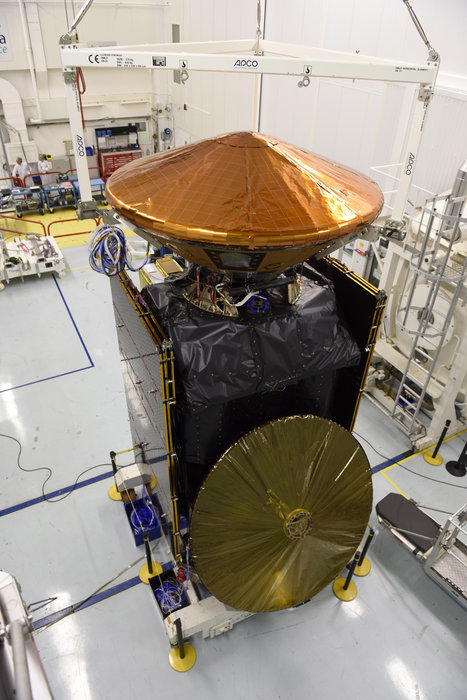
Schiaparelli, also known as the ExoMars Entry, descent and landing Demonstrator Module is seen here being installed at the top of the Trace Gas Orbiter, at Thales Alenia Space, in Cannes, France, on 25 November 2015.
The first mission of the ExoMars programme, scheduled to arrive at Mars in 2016, consists of a Trace Gas Orbiter plus an Entry, Descent and Landing Demonstrator Module (EDM). The main objectives of this mission are to search for evidence of methane and other trace atmospheric gases that could be signatures of active biological or geological processes and to test key technologies in preparation for ESA's contribution to subsequent missions to Mars.
The Orbiter itself will remain in Mars orbit to image surface features and study the composition of the atmosphere.
.
“It’s been a long road for ExoMars to reach this point, but we are now ready to launch in spring next year,” says Alvaro Gimenez, ESA Director of Science and Robotic Exploration.
“We are about to begin a new era of Mars exploration for Europe and our Russian partners.”
Sergey Saveliev, Deputy General Director of Roscosmos, says: “ExoMars is a unique example of the Russian–European cooperation in deep-space exploration.
“The mission of 2016 is just the first stage of our cooperation and, in the future, Roscosmos and ESA plan many joint projects to explore near and deep space.”
Donato Amoroso, deputy CEO of Thales Alenia Space, notes, “For Thales Alenia Space, our lead role in the extraordinary ExoMars programme, as producer of the orbiter and the entry, descent and landing module for in situ exploration of Mars, entails huge technological and human challenges.”
The first ExoMars is scheduled for launch on 14 March, at the start of a launch window that remains open until 25 March.
After a cruise of almost seven months to Mars, Schiaparelli will separate from TGO on 16 October for its entry, descent and landing in the Meridani Planum region on 19 October.
TGO, along with ESA’s Mars Express and NASA satellites already orbiting Mars, will relay data for the few days that Schiaparelli is expected to operate on its batteries.
Schiaparelli is primarily a demonstrator to prove a range of technologies enabling controlled landings on Mars in future, but it also carries a small science package to analyse its local environment once on the surface.
Meanwhile, after a series of aerobraking manoeuvres in 2017, TGO will enter orbit around Mars, from where it will take a detailed inventory of the gases in the planet’s atmosphere.
Of special interest are the abundance and distribution of methane: its presence implies an active, current source, and TGO will help to determine whether it stems from a geological or biological source.
“TGO will analyse ‘trace gases’ in the atmosphere,” says Håkan Svedhem, ESA’s project scientist. “Even though they make up less than one percent of the atmospheric inventory, they should provide key indicators to the nature of any active processes, helping us to determine just how ‘alive’ Mars may be today.
“TGO will also monitor seasonal changes in the composition and temperature of the atmosphere, and will map the subsurface to look for hidden water ice.”
Finally, TGO will also relay data from the rover and surface science platform of the 2018 mission.
.
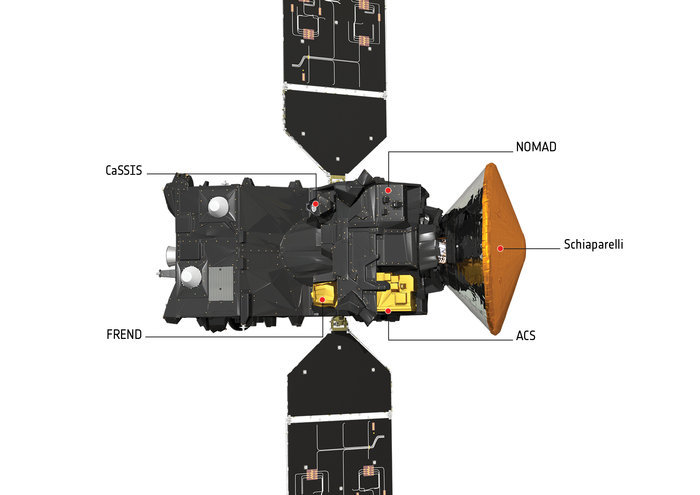
Artist’s impression of the ExoMars 2016 Trace Gas Orbiter (TGO) and Schiaparelli – the entry, descent and landing demonstrator module, with TGO’s instrument packages labelled.
ACS: Atmospheric Chemistry Suite
ACS is a suite of three infrared spectrometers to investigate the chemistry, aerosols and structure of the atmosphere. ACS will complement NOMAD by extending the coverage at infrared wavelengths.
CaSSIS: Colour and Stereo Surface Imaging System
This high-resolution camera (5 m per pixel) will obtain colour and stereo images of the surface covering a wide swath. It will provide the geological and dynamic context for sources of trace gases detected by NOMAD and ACS.
FREND: Fine Resolution Epithermal Neutron Detector
This neutron detector will map hydrogen on the surface down to a metre deep, revealing deposits of water-ice near the surface. FREND’s mapping of shallow subsurface water-ice will be up to 10 times better than existing measurements.
NOMAD: Nadir and Occultation for Mars Discovery
NOMAD combines three spectrometers, two infrared and one ultraviolet, to perform high-sensitivity orbital identification of atmospheric components, including methane and many other species, via both solar occultation and direct reflected-light nadir observations.
Quelle: ESA
.
Update: 20.12.2015
.
ExoMars loaded onto Antonov for shipment to launch site in Baikonur
Quelle: ESA
-
Update: 21.12.2015
.
Gute Nachrichten! ESA´s Exomars ist gut in Baikonur angekommen:
Quelle: ESA
.
Update: 5.01.2016
.
THE EXOMARS 2016 SCHIAPARELLI MODULE IN BAIKONUR
Title The ExoMars 2016 Schiaparelli module in Baikonur
Released 05/01/2016 12:52 pm
Copyright TsENKI
Description
On 14 March, the launch window opens for ExoMars 2016, ESA’s next mission to Mars, composed of the Trace Gas Orbiter and Schiaparelli.
Last month, the two spacecraft left Thales Alenia Space in Cannes, France, where they had been for the final few months of assembly and testing, and headed towards the Baikonur cosmodrome in Kazakhstan.
With both now in Baikonur, preparations are under way for the launch on a Russian Proton rocket during a window that remains open until 25 March.
The 600 kg Schiaparelli – pictured here being unpacked in a cleanroom in the cosmodrome – will ride to Mars on the Trace Gas Orbiter. Three days before they reach the Red Planet, Schiaparelli will separate from the orbiter, which will then enter orbit for a five-year mission of studying atmospheric gases potentially linked to present-day biological or geological activity.
Schiaparelli will enter the atmosphere at 21 000 km/h and slow by aerobraking in the upper layers, then deploying a parachute, followed by liquid-propellant thrusters that will brake it to less than 5 km/h about 2 m above the surface.
At that moment, the thrusters will be switched off and it will drop to the ground, where the impact will be cushioned by its crushable structure.
Less than eight minutes will have elapsed between hitting the atmosphere and touching down in a region known as Meridiani Planum.
Scientific sensors on Schiaparelli will collect data on the atmosphere during entry and descent, and others will make local measurements at the landing site for a short period determined by its battery capacity.
Schiaparelli will remain a target for laser ranging from orbiters using its reflector.
The module is named in honour of the Italian astronomer Giovanni Schiaparelli, who mapped the Red Planet’s surface features in the 19th century.
Quelle: ESA
-
Update: 21.02.2016
.
Giant nose in the sky’ ready for lift-off in mission to sniff out traces of life on Mars
The ExoMars probe will seek evidence of methane gas, which is seen as a crucial signpost of life

In a few days, space engineers will launch a probe that is designed to sniff out life on Mars.
The ExoMars robot spacecraft – which will blast off from the Baikonur cosmodrome in Kazakhstan on 14 March – will use a highly sensitive detector to determine whether methane, which is produced by living beings on Earth, exists in significant levels high in the atmosphere or near the surface of Mars.
The mission is designed to pinpoint hotspots that have high methane levels and that may provide the best prospects of finding life in the area. These would be targeted for future Mars missions.
“Essentially our spacecraft is a giant nose in the sky,” said Jorge Vago, the ExoMars project scientist. “And we are going to use it to sniff out the presence of methane on Mars and determine if it is being produced by biological processes.”
Most of the methane in Earth’s atmosphere is produced by micro-organisms, including many species that thrive in the guts of animals including cattle and termites. The gas’s presence in the atmosphere of Mars would provide strong support for the idea that life forms of some kind exist – or existed in the past.
To create a methane map of Mars, European Space Agency scientists have collaborated with Russian counterparts and designed ExoMars, a double mission whose first part will be launched in a few days and will put a probe, called the Trace Gas Orbiter, into orbit around the red planet. This will test for Martian methane. The probe will also test a package of landing equipment that could be used in the second part of the mission, a robot rover to be launched in 2018.
The Trace Gas Orbiter uses a suite of highly sensitive spectrometers, which can pinpoint the presence of the gas at extremely low levels. “Whiffs of methane have been detected by previous missions to Mars,” said Vago. “However, our detectors should be able to detect it at levels of only a few parts per trillion.”
The orbiter will use two approaches in its methane search. The first will involve viewing the planet at dawn and dusk, when the Sun will shine straight into the probe’s detectors. “This will give us detailed information about amounts of methane at different heights above the Martian surface,” said the Open University’s Manish Patel, who has designed some of the orbiter’s gas detectors. “The second part of our search will involve peering straight down on to the surface. In that way we will be able to map the planet’s methane hotspots.”
The orbiter’s spectrometers will be able to detect chemicals other than methane, however. They will also pinpoint other gases that will be vital in proving whether Martian methane has been produced by living entities or is merely the by-product of geological processes. “Some of the methane in our own atmosphere has come from geological processes, so we have to eliminate those as possible sources of the methane that we find on Mars,” said Patel. “That is a crucial part of our research.”
This point is emphasised by Vago. “If methane is found in the presence of other complex hydrocarbon gases, such as propane or ethane, that will be a strong indication that biological processes are involved. However, if we find methane in the presence of gases such as sulphur dioxide, a chemical strongly associated with volcanic activity on Earth, that will be a pretty sure sign that we are dealing with methane that has come from the ground and is a by-product of geological processes.”
The mission will also release a small landing craft called Schiaparelli, named after the Italian astronomer who, in the late 19th century, drew some of the first maps of Mars. The lander will beam back precise information about its behaviour as it descends through the atmosphere.
“Mars is one of the most difficult worlds in the solar system to land on and Europe has very little experience in settling probes safely on its surface,” said Stephen Lewis of the Open University, who has also been involved in the design of the spacecraft. “The information from Schiaparelli could be crucial in telling us what to expect when it comes to landing the second part of the mission – the robot rover – on the planet in two years.”
Quelle: theguardian
